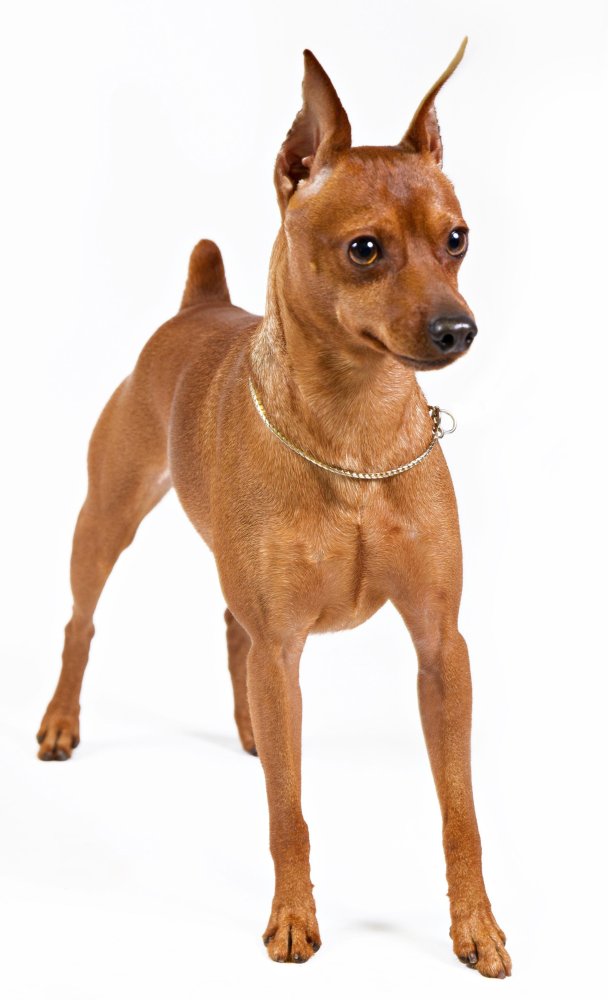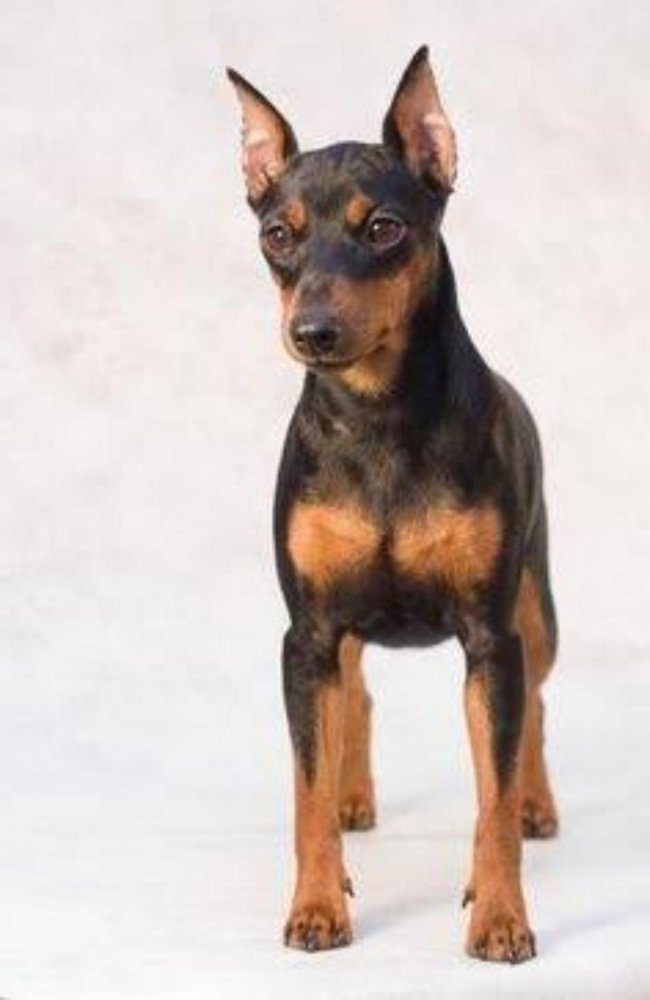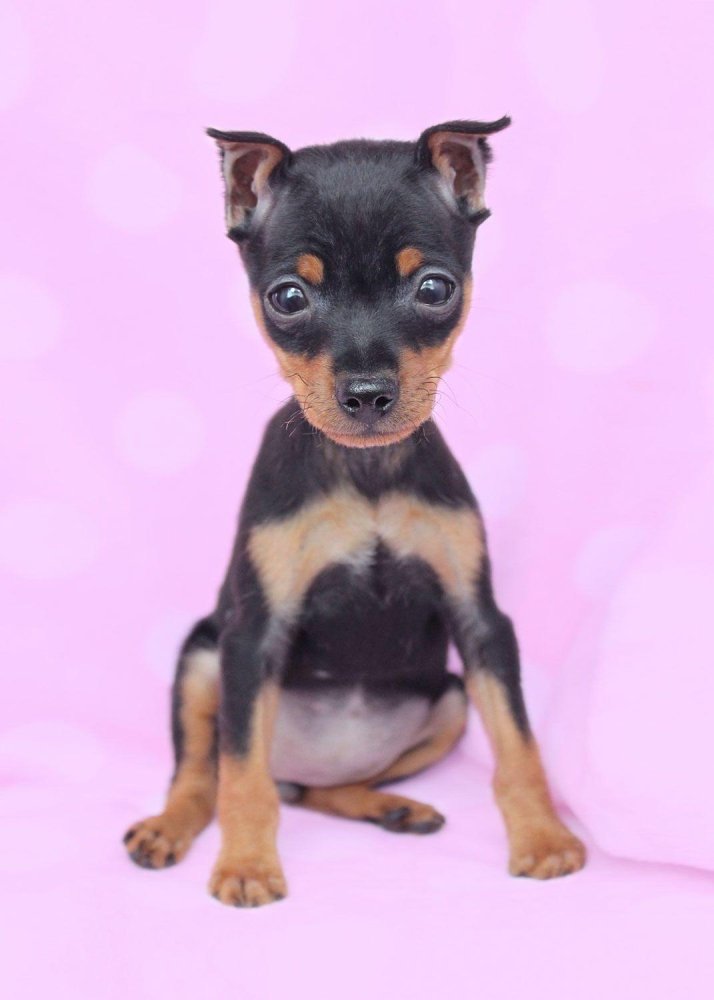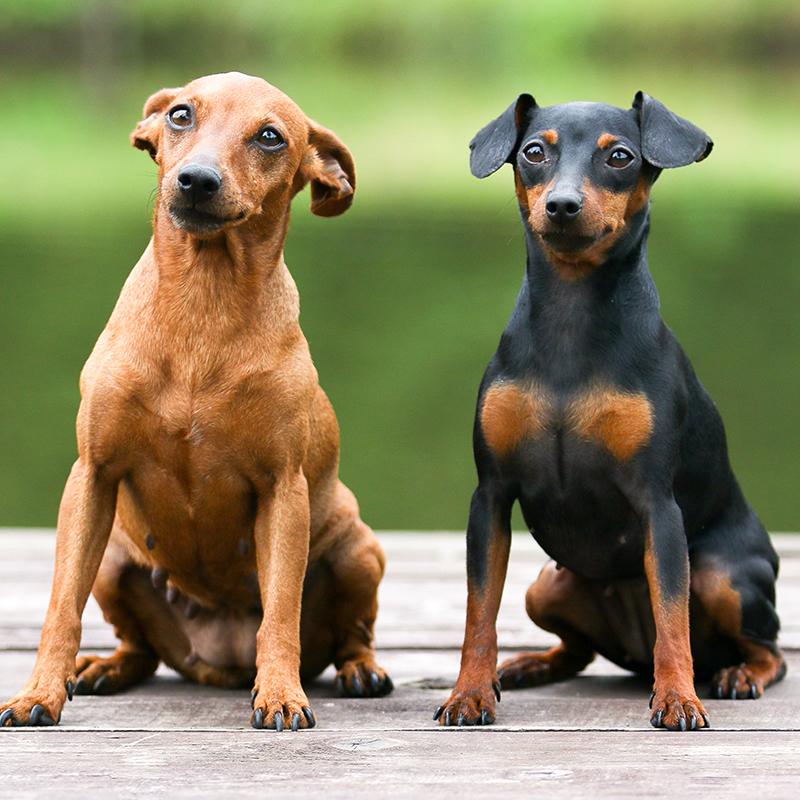- Breed Category: Toy Group
- Country of Origin: Germany
- Average Height: 25-30 cm (10-12 in)
- Average Weight: 4-5 kg (9-11 lbs)
- Average Life Span: 12-15 years
- Grooming Requirements: Low, occasional brushing
- Exercise Requirements: High, daily walks needed
- Coat Type: Short and smooth
- Coat Color Variations: Black, chocolate, red
- Shedding Level: Low
- Ear Type: Erect or cropped
- Tail Type: Docked or natural
- Temperament: Energetic, alert, fearless
- Intelligence Level: High
- Barking Tendency: High, alert barker
- Compatibility with Children: Moderate, supervision needed
- Compatibility with Other Pets: Moderate, early socialisation helps
- Training Ease: Moderate, consistent training needed
- Common Health Issues: Patellar luxation, eye issues
- Dietary Needs: High-quality, balanced diet
- Energy Level: Very high
- Drooling Tendency: Low
- Sensitivity to Weather: Sensitive to cold
- Overall Maintenance Level: Moderate
- Original Purpose: Ratting, companion
- Year of Recognition by Kennel Clubs: 1925
- Apartment Friendly: Yes, with enough exercise
- Best Suited For: Active families, experienced owners
- Cost of Ownership: Moderate
- Unique Traits: “King of Toys” nickname
- Popularity Rank: Popular in toy breeds
The Miniature Pinscher, often called the “King of Toys,” is a small yet spirited breed known for its lively personality and sleek appearance. These dogs are not just miniature Dobermans, as some might think, but a distinct breed with a rich history.
Originating in Germany, the Miniature Pinscher was bred to hunt vermin, particularly rats, in homes and stables. Their lineage includes the Dachshund and Italian Greyhound, contributing to their agility and elegance.
“The Miniature Pinscher is a small dog with a big personality, often described as fearless and fun-loving.”
– Renowned canine historian, Dr. Emily Carter
This article aims to inform readers about the breed’s unique characteristics, fascinating history, and essential care tips.
Early Development and Historical Significance

Early Development of the Breed
The Miniature Pinscher’s journey began in Germany, where it was developed to be a nimble and efficient ratter. This breed’s ancestors, including the Dachshund and Italian Greyhound, contributed to its unique blend of agility and grace. Over time, breeders focused on refining these traits, resulting in the spirited and elegant dog we know today.
Role in European Dog Breeding
In the tapestry of European dog breeding, the Miniature Pinscher played a significant role. Its distinct characteristics and lively temperament made it a popular choice among breeders looking to create a versatile and energetic companion. The breed’s popularity spread across Europe, influencing the development of other small breeds.
Key Historical Figures
Several key figures were instrumental in the Miniature Pinscher’s development. Notably, German breeders in the late 19th and early 20th centuries, such as Werner Jung, were pivotal in establishing breed standards and promoting its unique qualities. Their dedication ensured the Miniature Pinscher’s place in the canine world.
Physical Characteristics
Physically, the Miniature Pinscher is a compact and muscular dog, standing about 25 to 30 centimetres tall. Its sleek coat, typically in shades of red, black, or chocolate, adds to its elegant appearance. The breed’s high-set ears and alert expression reflect its lively and curious nature, making it a standout in any setting.
Appearance and Unique Traits
The Miniature Pinscher is a small dog with a big presence. Standing at just 25 to 30 centimetres, its compact and muscular build is both elegant and athletic. The coat is sleek and shiny, coming in striking colours like red, black, or chocolate, often with distinctive rust markings that add to its charm. Its high-set ears and alert expression give it a lively and curious look, always ready for action.
One of the breed’s standout features is its sleek, compact build, which contributes to its agility and speed. This physical trait, combined with its confident stance, makes the Miniature Pinscher a true head-turner. Despite its small size, it carries itself with a regal air, living up to its nickname, the “King of Toys.”
Temperament and Behaviour
Known for its spirited personality, the Miniature Pinscher is fearless and fun-loving. This breed is full of energy and always eager to explore its surroundings. It’s a confident little dog, often acting as if it’s much larger than it actually is. While it can be independent, it thrives on interaction and enjoys being part of family activities. Its lively nature makes it a delightful companion, always ready to entertain and engage with its human friends.
Personality and Suitability

Typical Personality Traits
The Miniature Pinscher is a bundle of confidence and curiosity. This little dog is always on the move, exploring its environment with a fearless attitude. Its high energy level means it’s always ready for a game or a walk, making it a lively addition to any household. Despite its small size, it carries itself with a big-dog mentality, often acting as if it’s the boss of the house.
Suitability as a Family Pet and Watchdog
As a family pet, the Miniature Pinscher is a great choice for those who appreciate an active and engaging companion. It’s not just a lap dog; it thrives on interaction and being part of the family. While its size might not intimidate intruders, its alert nature makes it an excellent watchdog, always ready to sound the alarm at any unusual activity.
Interaction with Children and Other Animals
Miniature Pinschers generally get along well with children, especially if they’re raised together. However, due to their energetic nature, supervision is recommended during playtime to ensure everyone plays nicely. With other animals, early socialisation is key. They can coexist peacefully with other pets if introduced properly, but their strong prey drive means they might chase smaller animals.
Training and Exercise Needs
Training a Miniature Pinscher requires patience and consistency. They’re intelligent and eager to learn, but their independent streak can sometimes make them a bit stubborn. Positive reinforcement works best. Regular exercise is essential to keep them happy and healthy. Daily walks, playtime, and mental stimulation are crucial to prevent boredom and destructive behaviour.
Training, Exercise, and Health
Importance of Early Training and Socialisation
Getting a Miniature Pinscher off to a good start with early training and socialisation is crucial. These little dynamos are full of energy and curiosity, so introducing them to different environments, people, and other animals early on helps them grow into well-rounded adults. It’s all about building confidence and reducing any potential anxiety or aggression.
Recommended Training Techniques
When it comes to training, patience and consistency are your best friends. Miniature Pinschers are smart but can be a bit headstrong. Positive reinforcement, like treats and praise, works wonders. Keep sessions short and fun to hold their attention. Remember, a well-trained Pinscher is a happy Pinscher.
Daily Exercise Requirements and Activities They Enjoy
These little guys need their daily dose of exercise to burn off all that energy. Think of brisk walks, playtime in the backyard, or even agility training. They love activities that challenge their minds and bodies. Keeping them active not only keeps them fit but also prevents boredom, which can lead to mischief.
Health and Lifespan
Miniature Pinschers are generally healthy dogs with a lifespan of around 12 to 15 years. Regular vet check-ups, a balanced diet, and plenty of exercise are key to keeping them in top shape. Be on the lookout for common issues like patellar luxation and dental problems. With the right care, your Miniature Pinscher can enjoy a long, healthy life.
Health and Care

Common Health Issues
Miniature Pinschers are generally robust, but like any breed, they have their share of health concerns. Patellar luxation, where the kneecap dislocates, is a common issue. They can also be prone to dental problems, so regular teeth cleaning is a must. Keeping an eye on their weight is important too, as obesity can exacerbate joint issues.
Average Lifespan and Health Tips
With proper care, Miniature Pinschers can live between 12 to 15 years. To keep them healthy, ensure they have a balanced diet and regular exercise. Mental stimulation is just as important, so engage them with interactive toys and training sessions. Regular vet visits are crucial to catch any potential health issues early.
Preventative Care Recommendations
Preventative care is key to a long, healthy life. Regular vaccinations, flea and tick prevention, and heartworm medication are essential. Routine dental care, including brushing and professional cleanings, helps prevent periodontal disease. Keep their nails trimmed and ears clean to avoid infections.
Grooming and Maintenance
Grooming a Miniature Pinscher is relatively straightforward. Their short coat requires minimal maintenance, just a weekly brush to remove loose hair. Bathing should be occasional, as needed. Regularly check their ears for wax build-up and trim their nails to keep them comfortable and healthy.
Coat Care and Grooming

Coat Care and Grooming Routines
Miniature Pinschers have a sleek, short coat that’s pretty low-maintenance. A quick brush once a week is usually enough to keep their coat looking shiny and healthy. This helps remove loose hair and distribute natural oils, keeping their skin in good condition. Bathing should be occasional, only when they get particularly dirty or start to smell.
Shedding and Seasonal Grooming Tips
These little guys do shed, but not excessively. During shedding seasons, like spring and autumn, you might notice a bit more hair around the house. A more frequent brushing routine during these times can help manage the extra hair. It’s also a good time to check their skin for any signs of irritation or dryness.
Diet and Nutrition
A balanced diet is crucial for a Miniature Pinscher’s health. High-quality dog food, appropriate for their age and activity level, is essential. They can be prone to obesity, so watch their portion sizes and avoid too many treats. Fresh water should always be available. Occasionally, adding some fresh fruits and veggies can provide extra nutrients and variety.
Nutritional Needs and Feeding Tips

Nutritional Needs for Optimal Health
Miniature Pinschers need a balanced diet to maintain their energy and health. High-quality dog food, rich in protein and healthy fats, is essential. Look for options with real meat as the first ingredient and avoid fillers like corn and soy. Omega-3 and Omega-6 fatty acids are great for their coat and skin.
Foods to Include and Avoid
Include lean meats, fish, and vegetables in their diet. Carrots and sweet potatoes are excellent for added vitamins. Avoid foods high in fat and sugar, as well as chocolate, grapes, and onions, which are toxic to dogs. Always ensure fresh water is available.
Feeding Schedules and Portion Recommendations
Feed your Miniature Pinscher twice a day to keep their metabolism steady. Portion sizes depend on their age, weight, and activity level, but generally, 1/2 to 1 cup of dry food per day is sufficient. Monitor their weight and adjust portions as needed.
Fun Facts and Trivia
Did you know the Miniature Pinscher is often mistaken for a young Doberman? Despite their similar looks, they are not related. Also, these little dynamos are known for their “hackney gait,” a high-stepping trot that adds to their unique charm.
Interesting Tidbits and Famous Miniature Pinschers

Interesting Tidbits about the Breed
The Miniature Pinscher, often affectionately called the “Min Pin,” is a breed full of surprises. Despite their small stature, these dogs are known for their fearless attitude and boundless energy. One quirky trait is their “hackney gait,” a high-stepping trot that makes them look like they’re prancing. This unique movement is a nod to their elegant and agile nature.
Another fun fact is that the Miniature Pinscher is not a miniaturised version of the Doberman Pinscher, as many assume. In fact, the Min Pin predates the Doberman and has its own distinct lineage. Their history as rat hunters in Germany has given them a strong prey drive, which is why they love chasing after toys or small critters.
Famous Miniature Pinschers in Media or History
While the Miniature Pinscher may not have as many famous representatives as some other breeds, they have made their mark in various ways. In the world of entertainment, these dogs have appeared in films and TV shows, often cast for their lively and spirited nature. Their striking appearance and confident demeanour make them a favourite choice for roles that require a small dog with a big personality.
In history, the breed has been a beloved companion to many notable figures, admired for their loyalty and charm. Their popularity in Europe during the early 20th century helped cement their status as a cherished breed, both in homes and in the show ring.
Final Thoughts

The Miniature Pinscher is a small dog with a big personality. Known for its fearless and energetic nature, this breed offers both challenges and rewards for dedicated owners. With proper training, socialization, and care, the Miniature Pinscher can be a delightful and loyal companion, thriving in active households. Embrace the lively spirit of the “King of Toys” and enjoy the unique bond this breed offers. Consider adopting a Miniature Pinscher if you’re ready for an engaging and spirited pet.
